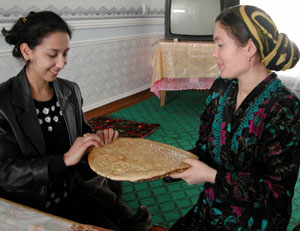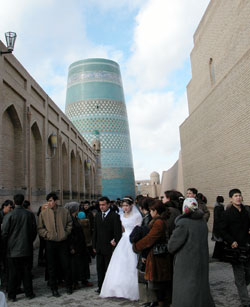News
On the Silk Road: Improving the Health and Welfare of Young People in Uzbekistan
- 02 October 2006
News
KHIVA, Uzbekistan — For centuries, this ancient, walled oasis flourished with trade in silk, carpets, furs and precious metals. A major link in the chain of cities along the famed caravan route known as the Silk Road, Khiva was not only a trading hub, but a crossroads of ideas and cultures.

The old city, nestled in the heart of modern Khiva, has been preserved as a World Heritage Site. People still live there as they have for centuries in thick, walled structures made from mud bricks. But now they have central heating and Internet connections.
True to its rich heritage, Khiva embraces old traditions while advancing new ideas. Like the country as a whole, the city is in transition between a planned economy and a market-oriented one, and between old and new ways of thinking about the challenges it now confronts.
One of the urgent challenges is how to provide for the health and well-being of its young people. Like much of the rest of Central Asia, Uzbekistan has a youthful population. The median age is just 24, while 40 per cent of the total population of 26 million is under the age of 16.
With many families living on the margins of poverty, the lack of jobs for young people is a big concern. Addressing their need for information and services to protect their sexual and reproductive health is another. This is becoming especially pressing as HIV prevalence, though still low, is rising dramatically.

“The reproductive health of adolescents requires special attention, but most are too embarrassed to visit a primary health-care facility or district hospital for advice and services,” says Dr. Klara Yadgarova, head of the Mother and Child Care Directorate, part of the Ministry of Health.
Pilot programmes in Khiva and a handful of other Uzbek cities are overcoming this barrier by offering training in practical skills such as carpet weaving and computer technology in youth centres, along with an array of youth-friendly health services and referrals. Attracted by word of mouth and a mass media campaign, young people come to the youth centre to learn, read or socialize. Whatever their reason for dropping in, however, they also have an opportunity to learn about reproductive health and family planning, says Lola Erniazova, the head of the Khiva branch of the Uzbek Association for Reproductive Health (UARH), which is implementing the youth centre project in collaboration with the Ministry of Health and UNFPA, the United Nations Population Fund.
An energetic middle-aged woman, Lola has lived and worked in Khiva her whole life. “When I was younger, we didn’t have these services or access to sound information,” she recalls. “Under the old system, women were encouraged to have as many children as possible. The result of this was very high birth rates, with many women pregnant nearly every year. The other result was high levels of maternal mortality and morbidity.”
The UARH initiative also uses trained peer counsellors to reach out to young people, both at the youth centres and through other outreach activities. Madina Madaminova, 23, who lives in the heart of Khiva and runs her own small business selling cosmetics has been a volunteer peer educator for the past three years. Trained under a UNFPA-financed programme, Madina is now on the cutting edge of change in her community.
“I visit households, schools and orphanages talking to young people about the dangers of early marriage, how to prevent sexually transmitted infections and HIV, and the need for birth spacing and family planning, among other topics,” she explains with an engaging smile. She also teaches carpet weaving and talks with young people informally about reproductive health at the youth centre.
The work has not always been easy, because it involves chipping away at cultural taboos, including fears that open discussion of sexuality and reproductive health will lead to premarital sex or promiscuity.
“This is a conservative community, and when I started working as a peer educator, some parents did not want me to discuss sexual and reproductive health issues with their children,” recalls Madina.

Over the past three years, however, the resistance has diminished as the project engaged community leaders and local media in discussion of the issues, including high rates of abortion, a growing number of sexually transmitted infections, and excessive maternal morbidity and mortality, often complicated by anaemia related to high levels of environmental pollution. Gradually, the community has come to recognize the need for access to information and services.
“Now I encounter few objections,” said Madina. “In fact, I’m known in the community and now I get invited to homes to discuss these issues openly. Most young people I encounter are eager for knowledge. The computer and weaving courses we give have also drawn in many more youth than would have been the case if the centres were just providing health services and information.”
Though she has encountered resistance from some members of the community, Madina enjoys the full-fledged support of her father, who is effusive about the work his daughter is doing. “In the beginning, some of my neighbours asked me why I let my daughter get involved in these sensitive issues,” recalls Kushnazar. “But I retorted, why not? Good reproductive health is necessary for development.”
The reproductive health of women and adolescents in the Province of Khorezm, where Khiva is located, as in three other provinces where UNFPA is active, has improved significantly. “We used to have 40 abortions for every 1,000 live births, but now that ratio has dropped fourfold -- to 9 abortions for 1,000 births,” says Lola. “Our maternal mortality ratio has also been cut in half, from a national average of 65 deaths for every 100,000 live births to 31.”
An increase in contraceptive use has played a major role in reducing the number of abortions and improving maternal health. Contraceptive prevalence continues to increase; currently some 67 per cent of married women use modern methods of contraception.
As for Madina, she is planning to continue as a volunteer. “Even after my marriage next year, I will still want to work with young women on these important issues,” she says. “We are making a real difference here in the lives of adolescents and youth. It is work that is vital for the future of our neighbourhood, our community and our nation.”
— Don Hinrichsen